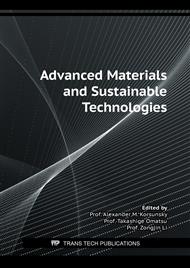[1]
P.G. Fookes: Tropical Residual Soils: A Geological Society Engineering Group (Geological Society of London, England 1997).
Google Scholar
[2]
S. Horpibulsuk, W. Katkan, W. Sirilerdwattana and R. Rachan: Soils Found. Vol. 46(3) (2006), p.351–366.
DOI: 10.3208/sandf.46.351
Google Scholar
[3]
S. Caro, J.P. Agudelo, B. Caicedo, L.F. Orozco, F. Patiño and N. Rodado:. Int. J. Pavement Eng. Vol. 20 (2018), p.1425–1434.
DOI: 10.1080/10298436.2018.1430893
Google Scholar
[4]
N.A. Wahab, M.J. Roshan, A.S.A. Rashid, M.A. Hezmi, S.N. Jusoh, N.D. Nik Norsyahariati and S. Tamassoki: Sustainability. Vol. 13(11): 6430 (2021).
DOI: 10.3390/su13116430
Google Scholar
[5]
A. Eisazadeh, K.A. Kassim and H. Nur: Environ. Earth Sci. Vol. 63 (2011), p.1057–1066.
Google Scholar
[6]
N. Yoobanpot, P. Jamsawang, P. Simarat, J. Pornkasem and S. Likitlersuang: J. Soils Sediments. Vol. 20 (2020), p.3807–3823.
DOI: 10.1007/s11368-020-02635-x
Google Scholar
[7]
A. Sharma and R. Ramkrishnan: Perspect. Sci. Vol. 8 (2016), p.198–202.
Google Scholar
[8]
L.S. Hasriana, M.N. Djide and T. Harianto: Int. J. Geomate. Vol. 15 (2018), p.114–120.
Google Scholar
[9]
A.S.A. Rashid, N. Latifi, C.L. Meehan and K.N. Manahiloh: Geotech. Geol. Eng. Vol. 35 (2017), p.2613–2623.
DOI: 10.1007/s10706-017-0265-1
Google Scholar
[10]
A.S.A. Rashid, S. Tabatabaei, S. Horpibulsuk, N.Z.M. Yunus and W.H.W. Hassan: Geotech. Geol. Eng. Vol. 37 (2019), p.5533–5541.
DOI: 10.1007/s10706-019-00944-8
Google Scholar
[11]
C.J. Lynn, G.S. Ghataora and R.K. Dhir OBE: Int. J. Pavement Res. Tech. Vol. 10 (2017), p.185–201.
Google Scholar
[12]
Y. Lu, A. Tian, J. Zhang, Y. Tang, P. Shi, Q. Tang and Y. Huang: Adv. Civ. Eng. Vol. 2020: 8886134.
Google Scholar
[13]
ASTM Standard C618, West Conshohocken, USA. (2012).
Google Scholar
[14]
ASTM Standard C1157, West Conshohocken, USA. (2015).
Google Scholar
[15]
A. Iyayuk, Promputthangkoon. P and A. Lukjan: Infrastructures. Vol. 7(66) (2022).
Google Scholar
[16]
ASTM Standard C1557, West Conshohocken, USA. (2017).
Google Scholar
[17]
DH-S Standards for Highway Construction, Thailand. (1990). (in Thai).
Google Scholar
[18]
ASTM Standard D2166, West Conshohocken, USA. (2016).
Google Scholar
[19]
A. Bhurtel and A. Eisazadeh: KSCE J. Civ. Eng. Vol. 24(2) (2020), p.404–411.
Google Scholar



